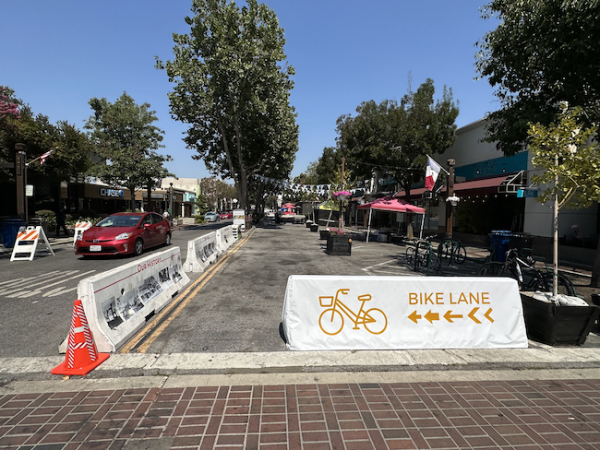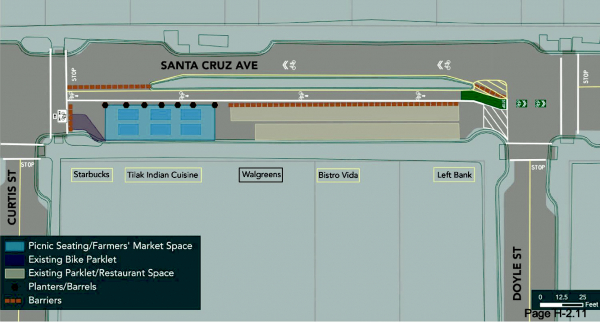UPDATED: September 5, 2023
The City Council needs to do even more this year!
After living in Menlo Park for almost 35 years, I have accepted the reality that our downtown never could become a “destination city” that successfully competes with the shopping, dining and entertainment experiences offered in nearby Redwood City, Palo Alto and the Stanford Shopping Center. However, I do think it could become a lot more appealing to residents and businesses, and believe there are many untapped opportunities to accomplish this objective. But success requires that successive city councils commit to this mission and pro-actively make the kinds of affordable small-scale, civic investments that together would make a huge difference. Only then will our downtown become a more enjoyable and visually attractive place to eat, shop, walk, attend small public events, stroll, and simply enjoy spending time with friends.
While the pandemic depressed downtown Menlo Park, two city adaptations have fortunately proved beneficial. The outdoor dining areas that the city helped restaurants finance - both initially and again during the pandemic, have become very popular spots, and the temporary public space located in front of Walgreens on the 600 block of Santa Cruz now attracts residents of all ages for social gatherings and small community events like the weekly gourmet food market. Both have enhanced our entire downtown.
On August 29, the City Council approved resolutions that will bolster this emerging momentum. I applaud their decisions and encourage them to do a lot more, as there are dozens of “low-hanging fruit” opportunities to make downtown a great place to visit.


Note: The new bike lane on the 600 block will improve the safety and convenience of bicyclists, pedestrians and motorists. And soon, new signage and street markings will assist bicyclists who ride between Curtis and El Camino.
Encouraging City Council Decisions
• Adopted "improving downtown" a strategic priority for fiscal year 2023-2024, a city decision that was long overdue. While this is a great start, this must remain a perpetual city objective, as BIG challenges will remain forever.
• Approved aesthetic design and safety standards plus competitive fee structures (and initial subsidies) designed to support outdoor dining areas on city property. Go here to view Agenda Item H-1 of the city staff report prepared for the city council meeting. The Council deserves a great deal of credit for carefully weighing the concerns and feedback of restaurant owners and other street users before making its decisions.
• Approved the conversion of the temporary community space on the 600 block into a “long term” public resource.
• Approved a new bike lane on the 600 block of Santa Cruz. Go here to view Agenda Item H-2 of the city staff report prepared for the city council meeting.

New layout of outdoor dining, bike lane and outdoor dining areas on 600 block
Tremendous Untapped Potential
Transforming downtown requires the city to adopt both (1) fundamentally different attitudes towards its role and responsibilities for making (and keeping) downtown an appealing place for Menlo Park (and Atherton) residents, businesses and visitors AND (2) adopt new strategies that go far beyond using conventional economic development activities to attract new businesses. It requires investments in the repair, cleaning, upgrading and creation of civic infrastructure. And these actions must be sustained indefinitely despite changes in the composition of the city council. Voters need to ensure they select council representatives that embrace this mission.
Downtown has a tremendous amount of untapped potential. The following are few strategies that could make a huge difference, and specific individual investments need to identified and prioritized.The city should also encourage, inspire and incentivize complementary private investments by businesses and building owners,
• Transform the 600 block public space into a well-designed plaza suitable for individual usage, informal gatherings and small community events.
• GIVE the entire Santa Cruz streetscape between University and El Camino a fresh well-designed facelift. Repaint all crosswalks with an attractive design and color palette.
• Ensure all streets, sidewalks, and other city "street fixtures" are ALWAYS well-maintained and clean.
• The surfaces in ALL parking plazas are in extremely poor (and dangerous) condition. They need to be resurfaced, re-striped, and well-maintained.
• Overall, become action-oriented and confident that it can successfully make adjustments to downtown, whenever important underlying assumptions change. Consider all important trade-offs when making big decisions but do not be either too cautious or conservative.
Additional Community Plaza Opportunities
• Replace the tables and umbrellas - graciously provided by Bistro Vida during the pandemic - with attractive commercial-quality street furniture.
• Create a city program to keep this public space clean. For example, steam wash it at least monthly to remove ugly stains from spilled food and beverages. Add polite signage that encourage users to respect this space and others who use it.
• Move bike parking to a convenient nearby location on Curtis Street. This would make additional space available for other activities and eliminate the clutter of bikes in front of Starbucks.
• Replace the existing street barriers, plants and trees with more attractive ones and maintain them so they do not become eyesores.
• Convert the public space into a true plaza by leveling the surface and using attractive hardscape materials.
Additional Santa Cruz Avenue Streetscape Opportunities
• Install (and maintain) street-level landscaping that is more attractive. Prune trees and eliminate spots where rats nest.
• Steam wash the street, and sidewalks at least one a month during spring, summer and winter months
• Upgrade the appearances of all street furniture, e.g., lamp posts, kiosk, after creating a beautiful, cohesive design.
• Require all restaurants with outdoor dining areas to keep their landscaping healthy and attractive.
Closing Thoughts
In 2012 the City of Menlo Park completed a five-year planning process that produced its existing comprehensive vision and plan for transforming downtown Menlo Park into a more economically viable and appealing central retail district. Unfortunately, the aspirational objectives, ideas and proposed civic investments that are included in the El Camino and Downtown Specific Plan have LARGELY been ignored by every successive city council. (Note: it’s also likely few residents even know what’s in it.) This failure demonstrates the futility of developing ambitious (and unrealistic) “top-down” plans for downtown Menlo Park when our city is unable to sustain a strong commitment to producing actual results.
Note: It is important NOT to conflate the missions and objectives of downtown REVITALIZATION and conventional economic development. While efforts to attract and maintain a successful mix of retail businesses are key to both, revitalization requires much broader set of well-conceived city strategies, investments, and regulations all designed to attract visitors for reasons other than simply shopping and dining.
We need to be honest with ourselves. The current vibrancy of the 600 block of Santa Cruz was not the result of proactive city planning and actions, but rather largely the result of conditions created by the pandemic and the tireless efforts of a single business owner who invested heavily in his own outdoor dining area, purchased tables and umbrellas for the public space, and held numerous special small-scale event in the public space. The successful 600 block experiment has demonstrated what can be learned and accomplished when the city supports “bottoms-up” community initiatives. These community-based efforts should be embraced and cultivated, not discouraged.
Menlo Park residents and businesses deserve a much better downtown. I hope our current city council is motivated enough by the unexpected great success of the 600-block experiment to make AMBITIOUS goals and decisions that would help our city achieve this objective within the next 2-3 years. A successful downtown is clearly doable and strategically affordable. But does the Council have the will and courage to pursue it? The amount of progress the Council makes in the next twelve months will reveal the answer.



